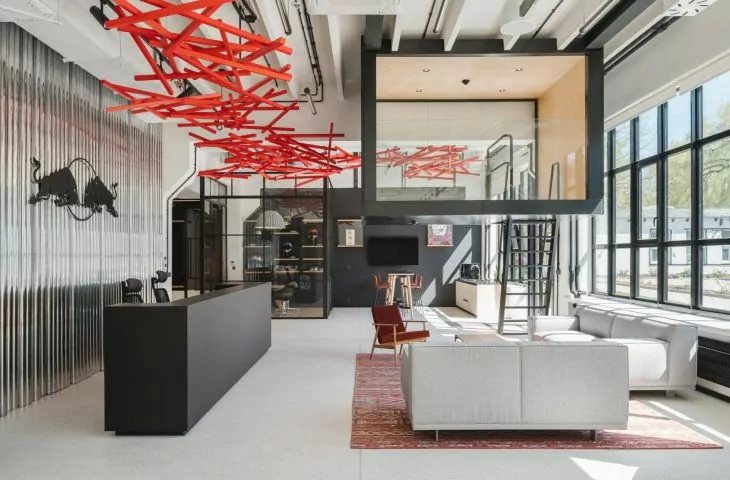In recent years we have learned to appreciate post-industrial heritage. It's hard to find more fashionable spaces today than spacious apartments in a loft atmosphere or industrial office interiors arranged in austere but functional post-industrial buildings. The recently completed Warsaw headquarters of Red Bull, arranged in a post-industrial hall from the 1970s located inside Fort Mokotow, fits perfectly into this trend.
left: the main entrance to the building; right: a cross-sectional view
Photo: Nate Cook Photography; © MXCF Architects.
Our goal in designing Red Bull's new headquarters was to create a comfortable, sustainable work environment that provides employees with a daily sense of well-being and a desire to be active, write the designers from MXCF Architects, who are responsible for the building's new interior design.
Industrial interior, or what kind of interior?
A post-industrial building was adapted for the needs of the company, and a functional space for office work, meetings, creative activities and relaxation was created on three floors (underground, ground and first floor). The existing building required some changes - the spaces of the hall were opened up and the prefabricated reinforced concrete structure was exposed, thus emphasizing the character of the building and proving that to create an industrial-style interior, it is not at all necessary to expose or create brick walls. The opening not only allowed for light on the thoroughfare running through the center, but also provided employees with a view of the greenery surrounding the building through large windows divided by black woodwork.



mezzanine with conference room, view of open space
photo credit: Nate Cook Photography
cross working
Inside the building, a variety of functions are interwoven - most of the second floor and first floor are occupied by naturally lighted open space, which, according to the project authors, is divided into semi-open zones that give both a sense of security andfacilitating direct contact between teams, space has also been set aside for meeting rooms of various sizes, including on mezzanines - in partially glazed boxes overlooking the office space, and publicly accessible booths for conversations and offices for quiet work have been introduced.
The 


open space and conference room on the 1st floor.
photo credit: Nate Cook Photography
All of these solutions, the designers emphasize, are designed to allow flexible and creative use of the workspace depending on the needs or type of tasks facing employees. Other features planned for the interior include a dining room, game and recording rooms, relaxation and meeting areas, as well as locker rooms for cyclists and, just off the lobby, a creative-workshop space with a video screen and an amphitheater made of plywood.
The 


place to prepare and drink coffee, 1st floor
Photo credit: Nate Cook Photography
Natural materials were used in the office - white terazzo floors, walls made of oak slats and shou sugi ban burnt wood, furniture built-ins made of birch plywood and black nanolaminate. The selection of furnishings is based on a combination of unpretentious office furniture and selected design classics, designers from MXCF Architects add.
The bright colors chosen for the office spaces on the walls, floors and ceilings, as well as natural materials, allow the industrial character of the building to "resonate". The whole is complemented by accessories that are strong color accents, such as an intense red installation placed over the main entrance and reception - Wave of Energy, orange elements visible on the chairs and bookcases, or deep blue walls and floor in one of the conference rooms on the second floor. Such solutions not only break up the sparing color scheme of the office, but also seem to emphasize the style of the energy drink brand.
Left: Wave of energy installation; right: view of one of the conference rooms
photo: Nate Cook Photography
To create a favorable working environment, care was also taken to provide solutions to improve the acoustics of the spacious hall - suspended acoustic islands, wall panels and carpets were used, among other things. In the lowest part of the building, the architects opted for an unusual solution - a skylight running along the facade, under which they created a green wall, which, as they note, changed the character of the underground floor, thus creating a bright, inviting space for relaxation.



cafe and game room in the underground
Photo credit: Nate Cook Photography
After pandemic isolation, the team can meet and collaborate again in a new office - authentic, inspiring and full of good energy, the project's authors assure.
If you like the industrial style in interiors, be sure to see the apartment in the former Pump Factory building in Leszno (proj.: Sikora Wnętrza Architektura).







































































